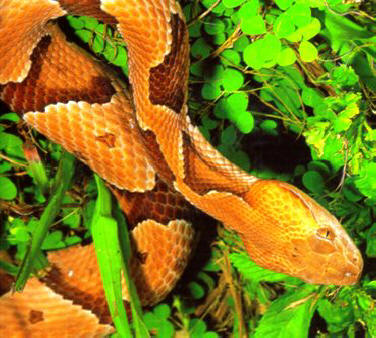Discover Florida Nature
It's time to explore the natural Florida


|
|
|
|
|
|
The average length of adult copperheads is 30 inches. They have an unmarked copper-colored head, reddish-brown, coppery bodies with chestnut brown cross bands that constrict towards the midline. Copperheads are thick-bodied and have keeled scales. The back of the Copperhead is marked with alternating dark and light brown bands, and the snake has two very small dark dots on the back of its copper colored head. Copperheads have heat-sensing "pits" located between the eyes and nostrils, hence the name "pit viper". The pattern on the Southern Copperhead is a series of hour-glass shapes. This venomous snake keeps the same markings throughout it's life, unlike the Water Moccasin. Their yellow eyes have elliptical or cat-like pupils. Although it lacks rattles, the Copperhead often vibrates it's tail when disturbed. Copperheads have a reputation for having a beautiful appearance and a nasty disposition. Southern copperheads are diurnal (active during daylight hours) during early spring and late fall, at which time they will generally depend on the ability of their bodies to blend in with their environment to obtain prey and avoid enemies. When coiled in a pile of leaves, the Copperhead is incredibly well camouflaged, and almost impossible to see. They are nocturnal during the summer heat, actively hunting for prey during the cooler evening hours. Southern copperheads often eat one single meal every three weeks-even during their most active months. Copperheads sometimes nest with other snake species during hibernation.  Copperheads
feed on baby cottontails, swamp rabbits,
rats, mice, birds,
snakes,
lizards, baby turtles,
frogs,
toads, and insects, especially grasshoppers and
cicadas. The Southern Copperhead is known to eat large quantities of
frogs, especially in the spring. They are preyed on by other snakes and
birds of prey. Copperheads
feed on baby cottontails, swamp rabbits,
rats, mice, birds,
snakes,
lizards, baby turtles,
frogs,
toads, and insects, especially grasshoppers and
cicadas. The Southern Copperhead is known to eat large quantities of
frogs, especially in the spring. They are preyed on by other snakes and
birds of prey. Males reach sexual maturity within two years, females in three. Mating season is in the spring from February to early May, shortly after leaving winter dens; and fall August to October with fertilization delayed until following spring. Like all Florida pit vipers, the Southern Copperhead bears live young. The fertilized eggs are kept inside the female's body until the eggs are ready to "hatch." Incubation time is 105 to 110 days. The four to eight young copperheads are 7-10 inches long and grayer in color than adults, weighing less than an ounce (28 g) at birth. Both young Florida copperheads and Florida Cottonmouths have yellowish tipped tails which fades with age and is lost by age 3 or 4. It is thought perhaps that the yellow tip functions as a worm like lure to attract frogs. Some people believe that the bite of a baby venomous snake is more powerful than that of an adult. Actually, there is no difference in the venom's potency, regardless of the age of the snake. Snake venom's most important function is to kill animals to be eaten. Defense is only a secondary function. Like all vipers, southern copperheads use the "heat seeking pits" behind their eyes to help locate their prey. Lying motionless on a bed of dead leaves, the pale-brown and chestnut-colored southern copperhead is all but invisible-a regular stealth viper! These are venomous snakes, but they are slow-movers, and depending on the season, they often share habitats with their prey. The Southern copperhead is generally inoffensive, but can be easily irritated. Herpetologists are not in agreement as to the potency of this vipers venom. Some maintain that its bite is unlikely to result in death; others say that a well placed bite could readily cause death. At any rate, the bite can be very painful and cause serious tissue deterioration. This snake should not be treated carelessly. |
|
|
Advertise | Privacy Statement | Dog Encyclopedia | Video |Contact | Alaska Nature |
|